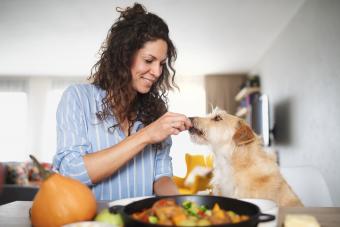
Using pumpkin is a great way to firm your dog's stools. If you've owned a dog, then most likely you have had to deal with your pup's upset tummy some time in their life. Gastrointestinal (GI) upset in dogs shows up primarily as diarrhea. Fortunately, a dose of canned pumpkin in your dog's diet can help during those times when their stool is not as firm as it should be.
How Pumpkin Helps Your Dog's Diarrhea
Pumpkin is a fiber-rich food that also contains important vitamins such as A, E, C, and K. Pumpkin also is a good source of iron, potassium, and magnesium.
Soluble and Insoluble Fiber
Pumpkin contains insoluble and soluble fiber; both are important to your dog's overall GI health. Insoluble fiber helps absorb water and adds bulk to the stool. Soluble fiber forms a kind of gel in the stomach and delays the speed of digestion. Both types of fiber help when a dog is suffering from loose stools. Because it does contain both insoluble and soluble fiber, it is not only a remedy for diarrhea, but for constipation, as well.
In other words, when there is extra moisture in your dog's GI tract, soluble fiber acts as a sponge (diarrhea). Insoluble fiber, on the other hand, attracts moisture into your dog's GI tract when the stool is hard and dry (constipation) to bulk up and soften the stool.
Maintains Beneficial Gut Flora
Fiber is also a prebiotic. Prebiotics act as "food" for probiotics, the tiny living organisms that help maintain beneficial gut flora and healthy digestion.

How Much Pumpkin to Use
A general guideline for the amount of pumpkin to feed to your dog is 1 tablespoon per meal for large dogs. For small to medium dogs, 1 to 2 teaspoons should do the trick. Too little won't help, and too much fiber can worsen your dog's diarrhea, or cause diarrhea if you are using it for constipation. To ensure your dog does not have any sensitivities or allergies to pumpkin, providing less than the guideline to begin with is recommended.
What Kind of Pumpkin Should Be Used?
It is important to note that the pumpkin being referred to here is canned, pure pumpkin, and not pumpkin pie filling. Pumpkin pie filling is used for baking and contains seasonings and sugar. Be sure to check the label before offering canned pumpkin to your pup. The ingredients should include pureed pumpkin and nothing else.
If you really want to make sure there are no additives, you can grab a pumpkin yourself and puree to the desired consistency. If you offer your dog fresh pumpkin, make sure to remove any raw pumpkin seeds and innards, as these may take away the benefits you were striving for in the first place. Plus, the innards aren't digestible to your dog.
Is Pumpkin Enough?
Usually, pumpkin alone isn't enough when your dog has a case of diarrhea. It makes sense to start a bland diet along with adding in pumpkin as a fiber source. A basic bland diet recipe consists of:
- Chicken or turkey.
- Boiled white rice.
- Plain yogurt.
Check with your veterinarian for the proper amount of each ingredient to feed your canine companion.
Cooking for Your Dog
Some dogs seem to have a naturally sensitive GI system. If you find that your dog suffers from loose stools more than once or twice a year, they might be a candidate for a homemade diet. A healthy and simple recipe that fits the needs of most dogs contains a balance of:
- High quality protein.
- Fat.
- Carbohydrates.
- Calcium.
- Essential fatty acids.
- Vitamins and minerals.
Consult the website BalanceIt for help in creating the perfect recipe for your dog's needs. You can plug in the ingredients and find the ideal ratios of each food to meet your dog's nutritional requirements.

Pumpkin Dog Treats
Commercially available dog treats aren't ideal for a dog with a sensitive GI system. For these pups, it's a good idea to have some healthy pumpkin dog treats on hand. You can add one fourth to one half of a can of pureed pumpkin to any of these dog biscuit recipes for a nice alternative to store-bought goodies.
How Long Does Pumpkin Take to Work?
Most cases of simple diarrhea will resolve with pumpkin and a bland diet in one to three days. If your dog is very young or very old, always talk to your veterinarian at the first sign of loose stools. In addition, if your dog is acting lethargic, vomiting, or is having bloody diarrhea, then call your veterinarian right away. If you attempt feeding pumpkin to alleviate a GI ailment and it doesn't work within 24 hours, consult your veterinarian. A dog with diarrhea that is acting otherwise normal, and still has an appetite and good energy levels, may benefit from some pumpkin therapy in their diet.







